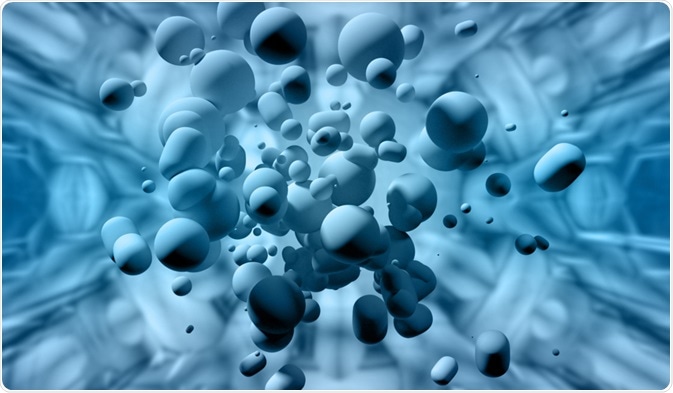Nanoparticles are important scientific materials that have applications in biotechnology and pharmacology. They bridge the gap between bulk materials and molecular structures.

GiroScience | Shutterstock
While bulk materials have constant physical properties regardless of size, the size of a nanoparticle dictates its physical and chemical properties. Thus, the properties of a material change as its size approaches nanoscale proportions and as the percentage of atoms at the surface of a material becomes significant.
Types of Nanoparticles
Nanoparticles are classified as 0-Dimensional (D), 1D, 2D, or 3D depending on their overall shape.
1-D nanomaterials
1-D nanomaterials have thin films or surface coatings and are used in the circuitry of computer chips and for anti-reflective properties and hard coatings on eyeglasses. These have been used in electronics, chemistry, and engineering.
2-D nanomaterials
2-D nanomaterials have fixed and long nanostructures with thick membranes. They are used to prepare nanopore filters used for small particle separation and filtration. Asbestos fiber is an example of 2D nanoparticles.
3-D nanomaterials
3-D nanomaterials are fixed and small nanostructures where thin films are deposited under conditions that generate atomic-scale porosity, colloids, and free nanoparticles with various morphologies.
Unlike 1-D nanomaterials, 2-D and 3-D nanomaterials pose health risks due to their free long aspect ratio nanowires and nanoparticles, respectively.
Hard nanoparticles
These nanoparticles impart their properties to polymers. Clay nanoparticles, when incorporated into polymer matrices, increase reinforcement leading to stronger plastics. Hard nanoparticles have also been used in textile fibers to create smart and functional clothing.
Semisolid or soft nanoparticles
Of the many semi-solid and soft nanoparticles that have been manufactured, liposomes are of particular significance. Various types of liposome nanoparticles are used clinically such as delivery systems for anticancer drugs, antibiotics, antifungal drugs, and vaccines.
Magnetic nanoparticles
Magnetic nanoparticles have varied applications ranging from data storage to diagnostic applications such as clinical imaging. These nanoparticles are manipulated by the use of magnetic field. For instance, ferrite nanoparticles with a size smaller than 128nm become supraparamagnetic thereby preventing self-agglomeration. The stability of ferrite nanoparticles in a solution can be increased by modifying their surface using surfactants, or derivatives of phosphoric acid or silicon.
However, the magnetic property of nanoparticles can also be of disadvantage in certain situations. For example, ferroelectric materials smaller than 10 nm can switch their magnetization direction using room temperature thermal energy, thus making them unsuitable for memory storage.
Physical properties of nanoparticles
Nanoparticles consist of three layers: the surface layer, the shell layer, and the core. The surface layer usually consists of a variety of molecules such as metal ion, surfactants, and polymers. Nanoparticles may contain a single material or maybe consist of a combination of several materials. Nanoparticles can exist as suspensions, colloids, or dispersed aerosols depending on their chemical and electromagnetic properties.
The properties of nanoparticles are dependent their size. For instance, copper nanoparticles than are smaller than 50 nm are super hard materials and do not exhibit the properties of malleability or ductility of bulk copper. Other changes that are dependent on the size of nanoparticles are superparamagnetism exhibited by magnetic materials, quantum confinement by semiconductor Q-particles, and surface plasmon resonance in some metal particles.
Research has also demonstrated that absorption of solar radiation in photovoltaic cells is much higher in nanoparticles than it is in thin films of continuous sheets of bulk material. This is because nanoparticles are smaller and can absorb greater amount of solar radiation.
Nanoparticles exhibit enhanced diffusion at elevated temperatures due to their high surface area to volume ratio. This property of nanoparticles allows sintering to take place at lower temperatures than in the case of larger particles. While this diffusion property exhibited by nanoparticles may not affect the density of the product, it can lead to agglomeration.
Application of nanoparticles
Nanoparticles are widely used in bioimaging applications due to their ability to produce varying intensity of colors in solutions by changing the thickness of the nanoshell, the aspect ratio, and the percentage of gold. For instance, a 20-nm gold produces a wine red color solution while a 20-nm platinum produces a yellowish-gray solution.
Some nanoparticles such as gold nanoparticles also have the advantage of melting at much lower temperatures (~300 °C for 2.5 nm size) than their bulkier counterparts (gold slabs melt at ~ 1064 °C).
Nanoparticles have also been used in cosmetic technology. For instance, zinc oxide particles have been found to have superior UV blocking properties compared to its bulk substitute. Therefore, it is used in the preparation of sunscreen lotions.
Further Reading